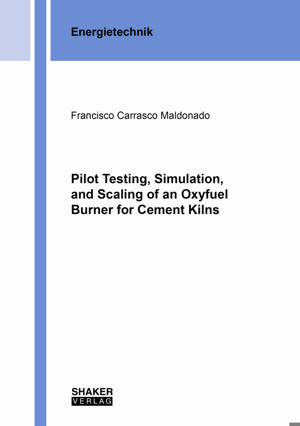
- Afhalen na 1 uur in een winkel met voorraad
- Gratis thuislevering in België vanaf € 30
- Ruim aanbod met 7 miljoen producten
- Afhalen na 1 uur in een winkel met voorraad
- Gratis thuislevering in België vanaf € 30
- Ruim aanbod met 7 miljoen producten
Zoeken
Pilot Testing, Simulation, and Scaling of an Oxyfuel Burner for Cement Kilns
Dissertationsschrift
Francisco Carrasco Maldonado
€ 45,45
+ 90 punten
Omschrijving
In the context of the present work the combustion concept oxyfuel, which entails the combustion to take place in an O2/CO2 atmosphere instead of air is investigated with reference to its application in cement kilns. Pilot testing at a 500 kWth once-through furnace and numerical simulations were employed to investigate the influence of high CO2 atmosphere and burner configuration on the combustion behavior of selected fuels. To investigate oxyfuel combustion in relevant cement production conditions, a modern kiln burner was scaled down and used as a prototype in the test rig. Conducted investigations in pilot-scale show that oxygen concentration in oxyfuel mode plays an important role in achieving an air-firing-like temperature profile. Flame length is also influenced under oxyfuel operation. As the oxygen concentration increases in combustion gas, the flame length shortens and the concentration of CO rises in the near burner region due to the influence of heterogeneous and homogenous reactions with CO2. Further, the operation in oxyfuel mode opens the possibility to redistribute the oxygen mass flow in the primary and secondary gas stream to optimize combustion behavior. According to the tests conducted, when the oxygen concentration is increased in primary gas (with a corresponding decrease in secondary gas) the generation of CO in the near burner field decreases significantly. Finally, full-scale CFD simulations of a cement kiln show that the results in pilot scale can be applied to replicate similar temperature profile as in air-blown combustion with a slight increase in radiative heat fluxes to wall. According to these results, the prototype burner can be used to retrofit a cement kiln for operation in oxyfuel mode.
Specificaties
Betrokkenen
- Auteur(s):
- Uitgeverij:
Inhoud
- Aantal bladzijden:
- 127
- Taal:
- Engels
- Reeks:
Eigenschappen
- Productcode (EAN):
- 9783844082494
- Uitvoering:
- Paperback
- Afmetingen:
- 149 mm x 8 mm
- Gewicht:
- 191 g

Alleen bij Standaard Boekhandel
+ 90 punten op je klantenkaart van Standaard Boekhandel
Beoordelingen
We publiceren alleen reviews die voldoen aan de voorwaarden voor reviews. Bekijk onze voorwaarden voor reviews.











